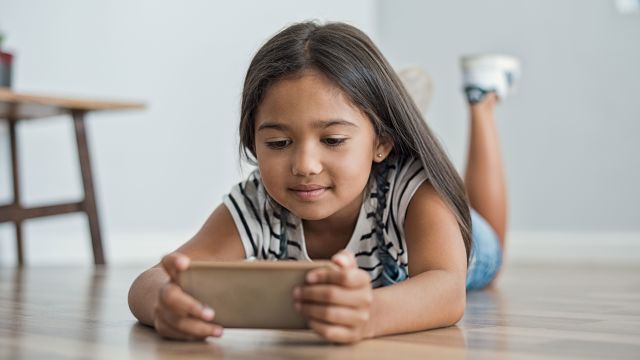Updated on October 23, 2024.
From classroom computers to bedroom televisions to the smartphones that seem stuck to their hands, screens have invaded every part of kids’ lives. And excessive time spent staring at screens can be bad for their development, no matter their age.
“Too much screen time can lead to more behavioral problems, attention problems, a sedentary lifestyle, weight gain, and childhood obesity,” says Elliot Freed, DO, a family medicine doctor in Pembroke, Virginia. For older kids, untold hours spent glued to a display is connected to mental health issues, as well.
A surge in screen use during COVID
These issues may have been exacerbated during the COVID-19 pandemic. Many school-aged children were locked down and learning online for much of the time, unable to go to school or participate in activities.
A report posted online in September 2020 on PsyArXiv (Psychology Archive) found that more than half of children ages 6 to 12 had increased their screen time by 50 percent in the early months of the pandemic. In a separate ParentsTogether survey from April 2020, almost half of parents surveyed said their children were online more than six hours a day, up from 8 percent or parents queried before the pandemic. Another one-quarter of kids were spending more than eight hours a day on a screen.
Screen time has also surged among the youngest children over the years. Between 1997 and 2014, daily screen time more than doubled among those younger than 2 years, according to a study published in JAMA Pediatrics in February 2019. In 1997, daily screen time for toddlers averaged around 1.32 hours and included TV and video viewing, video games, and time spent on home computers. By 2014, young children spent an average of three hours per day in front of screens as more devices—including smartphones, tablets, and e-readers—became available. During the pandemic, toddlers’ screen time increased by an additional 30 minutes daily, according to a February 2022 study in Scientific Reports.
As a result, many experts are concerned about the effects of devices on kids’ brain development. A study published in JAMA Pediatrics in 2019 found that increased unsupervised screen time was associated with less white matter in the brains of 3- to 5-year-olds. White matter plays a crucial role in language, literacy, and cognitive abilities.
In a world where screens are inescapable—and often a necessary part of life—how can parents and guardians find a happy medium? How can we balance the reasonable, potentially beneficial use of devices in educational settings with recreational use like social media and TV?
Screen time for younger children
Experts believe television holds no benefit for babies and toddlers. For one thing, since children ages 2 and younger don't understand what's happening on TV, they don’t learn anything, even from programs meant to be educational. For another, interaction with real-live people and objects is crucial to their development. Excessive TV exposure can detract from this in-person contact and may even cause delays in language and social-emotional development. Babies’ and toddlers’ sleep could suffer, as well.
The American Academy of Pediatrics (AAP) recommends minimizing or eliminating the use of media for children younger than 18 months. One exception is video chatting, which children may use to interact with family members.
For children between 18 and 24 months old, the AAP advises the digital media may be used as long as the programming is of a high quality and parents access the programming with their children. The AAP advises against letting children of this age view media on their own.
Once a child hits preschool—between the ages of 2 and 5—the AAP advises no more than one hour of media per day. The organization stresses that less is better and that real-world activities that engage their bodies and minds are always preferable.
Since content matters, the focus should be on high-quality programs—think Sesame Street or Mister Rogers’ Neighborhood. Co-viewing with your child is one way to regulate how long they watch and help them understand what's happening onscreen. Educational apps and games are often introduced at this age, as well. Since their efficacy is still being studied, parents should monitor their children's usage.
Screen time for older children
As kids get older, screen use becomes more complicated. Many need to use computers for school and the introduction of smartphones opens up a world of social interaction.
Perhaps because of this, the AAP does not set a specific limit on how much children ages 5 and up should interact with media. They do, however, say that parents should place limits to ensure kids are not choosing media at the expense of their health.
Kids should be sleeping well, spending time with family and friends, and getting enough physical activity. Too much time with devices can lead to deficiencies in these areas. While there’s plenty of research suggesting that too much time in front of a screen can increase a child's risk of obesity, the odds are even higher if they have a TV in their own bedroom.
Excess screen use may contribute to mental health issues, as well. One 2021 study in The Lancet Child & Adolescent Health, for example, found that more than an hour of screen time daily negatively affected the life satisfaction of adolescents and teens.
How to manage your child's screen time
The best solution? “Everything in moderation,” says Dr. Freed. Parents have the ability and responsibility to influence how and when their children interact with media. Here’s how:
Create media-free zones
Face-to-face interactions with family members and friends are essential for your child’s development. So, designate times and areas of your house that will remain media-free, such as the dinner table, the study area, and bedrooms. You can either verbally agree on these hours and places, or they can be written down in what the AAP calls a “family media plan.” This document can help you specify restricted and unrestricted media use within your home.
Limit tech use before bed
Using a phone before bed can stimulate children and cause insomnia or worsen sleep quality. Try cutting off screen time 60 minutes prior to bedtime. If children are having trouble falling asleep, you might shut things down even earlier.
Limit extra screen time
Even though remote learning stopped as the pandemic resolved, screens have continued to be an integral part of classrooms. Students increasingly take notes on computers and many learning programs and books are only available online. If your high schooler is already spending two to three hours in front of a screen for class or to complete their homework, you may want to cut down on anything beyond that.
“Limit extra screen time for the older children who might, out of necessity, need increased screen time,” says Freed.
Monitor media use
What your child watches matters, especially when they're younger. Co-viewing can help, since you can explain what they see. Common Sense Media is a good resource for parents looking to discover high-quality programming, as well as reviews of the shows your kids are already watching.
Encourage exercise
Limiting screen time is important, but exercise is also essential. The U.S. Department of Health and Human Services’ physical activity guidelines recommend that children older than 6 years of age participate in moderate-intensity activity for at least 60 minutes each day. The activity should be of vigorous intensity at least three days a week. Kids and teenagers between ages 6 and 17 should also incorporate muscle-building and bone-strengthening activities at least three days per week.
Moderate-intensity exercise includes brisk walking, hiking, and sports like baseball, swimming, and dancing. Vigorous activity comprises activities like jumping rope, biking, and faster-paced games like soccer, basketball, or flag football.
Young children—infants, toddlers, or preschoolers—should be allowed unlimited active playtime, as long as they are in a safe environment. Following these recommendations could help reduce your child’s risk of heart disease, type 2 diabetes, and many more short- and long-term health conditions.
Talk about touchy subjects
Whatever your kids' ages, as a parent, you can make sure they're using media safely and not engaging in online bullying or interacting with sexually explicit material. Discuss the dangers that online harassment can pose to your child and to other people.
As an adult, it’s ultimately up to you to model good tech behavior. Limiting your own screen time and using media wisely may be the most effective tools you have for teaching your child good screen habits.







